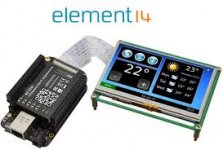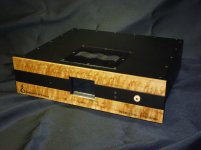I'll prepare a PI image of Volumio with those included. Then BBB
Thanks!
I am definitely still open to using the BBB.
I did use it with volumio for a while, but they were not supporting I2S out at the time. I will check again.
What's great is that even though the rpi may seem humble, it actually makes a really good streaming appliance! I am actually quite impressed. It easily beats a Squeezebox etc...
I will let you know what I find with the BBB
In what way does it easily beat the Squeezebox?
In what way does it easily beat the Squeezebox?
Less format converting necessary at least!
I have exciting news there too!
Look for another thread coming soon. I actually have something far better than AC2 already working. Brian and I are just finalizing the design.
Here is a teaser...
Are we actually looking at a bluetooth enabled buffalo? That is quite a tease! Will it be possible for a mac / iOS developer to help create a user friendly app for that?
In what way does it easily beat the Squeezebox?
- Sample rates up to 384khz and 32bit frames.
- Soon- Direct DSD (just about and DSD format should be doable) support without DoP
- Direct output to DAC without any need for USB/SPDIF or hacking a SBTouch for PCM.
- Hardware level control of DAC/CODEC via I2C
- For about $40-50(rpi) you can have a complete solution with wifi.
- Streaming from vanilla NAS or filesystem - no need for any specialized server.
I am sure I missed a few.
Are we actually looking at a bluetooth enabled buffalo? That is quite a tease! Will it be possible for a mac / iOS developer to help create a user friendly app for that?
yes you are - and yes it would.
Apps can pretty easily be create for PC/MAC/Android (4.3 and up)/iOS (versions that support BLE)
I wrote that little android app in a few hours.
My little BLE module takes the place of the on-board controller - it reads the port expander to setup the DAC, and allows control of volume from client app (phone is this case) as well as reporting the current sample rate. I am still enhancing it, but we are planning on making the module available to all soon.
It's actually a bit off topic for this thread, but I will start another introducing it.
Cheers!
Russ
I forgot to mention the the BLE module also is supporting physical interface at the same time. I am using a rotary encoder with push in switch for manual control at the DAC. There is also an OLED character display for fun (but its not at all needed). Changes at the DAC are immediately reflected in the APP.
Last edited:
BLE for IIIse?
Is this applicable to the IIIse also, or just to the III? I'm more excited about the direct I2S interface, but this BLE would really be icing on the cake!
yes you are - and yes it would.
My little BLE module takes the place of the on-board controller - it reads the port expander to setup the DAC, and allows control of volume from client app (phone is this case) as well as reporting the current sample rate. I am still enhancing it, but we are planning on making the module available to all soon.
Cheers!
Russ
Is this applicable to the IIIse also, or just to the III? I'm more excited about the direct I2S interface, but this BLE would really be icing on the cake!
yes you are - and yes it would.
Apps can pretty easily be create for PC/MAC/Android (4.3 and up)/iOS (versions that support BLE)
I wrote that little android app in a few hours.
My little BLE module takes the place of the on-board controller - it reads the port expander to setup the DAC, and allows control of volume from client app (phone is this case) as well as reporting the current sample rate. I am still enhancing it, but we are planning on making the module available to all soon.
It's actually a bit off topic for this thread, but I will start another introducing it.
Cheers!
Russ
Sounds promising, will be looking out for the thread.
.
- Sample rates up to 384khz and 32bit frames.
- Soon- Direct DSD (just about and DSD format should be doable) support without DoP
- Direct output to DAC without any need for USB/SPDIF or hacking a SBTouch for PCM.
- Hardware level control of DAC/CODEC via I2C
- For about $40-50(rpi) you can have a complete solution with wifi.
- Streaming from vanilla NAS or filesystem - no need for any specialized server.
I am sure I missed a few.
This is a completely new subject to me hence the questions
You may have seen I have just built a BIII Dac with the arduino controlling it, see photo.
With the rpi or BBB can I do the same thing (no arduino obviously) but have the screen (see photo) showing the album art etc? If I can theres a DAC for sale
What would you use to control it, remote wise? A phone I assume
Maybe install a SSD & have a stand alone solution with the wireless as well.
David
Attachments
Last edited:
Russ can I ask about your music server setup -
I'm interested to know how much "work" the rPi is doing.
You could, for example, set up a system where the rPi acts purely as renderer. The MPD server runs elsewhere, and an MPD client/controller runs elsewhere.
In such a scanario I wonder if the modest demand upon the rPi might maximise SQ?
I have mine (Raspberry Pi) streaming directly from NAS (an ASUS RT-AC66U with a USB SSD drive) at up to 192Khz sounding superb!
You're running an MPD server, right? Is MPD installed on the rPi, or on some other computer on the network?I found the best results streaming via network (both wired and wireless) from NAS.
I'm interested to know how much "work" the rPi is doing.
You could, for example, set up a system where the rPi acts purely as renderer. The MPD server runs elsewhere, and an MPD client/controller runs elsewhere.
In such a scanario I wonder if the modest demand upon the rPi might maximise SQ?
This is a completely new subject to me hence the questions
You may have seen I have just built a BIII Dac with the arduino controlling it, see photo.
With the rpi or BBB can I do the same thing (no arduino obviously) but have the screen (see photo) showing the album art etc? If I can theres a DAC for sale
What would you use to control it, remote wise? A phone I assume
Maybe install a SSD & have a stand alone solution with the wireless as well.
David
You could absolutely control the whole DAC with the BBB/pi using a display, mobile. and/or web UI.
The embedded systems support I2C - so writing something to control the DAc would be no real trouble.
Regarding direct DSD, I remember the discussions on the MPD developer mailing list when DoP was first introduced (Dec 2011).
A patch was contributed by a third party, which worked fine, but the MPD author (Max Kellerman) didn't like it! He though that DoP itself was messy, and it took some convincing before he added DoP support upstream.
So I think that Max will be receptive to any form of DSD support which is an alternative to DoP. If the new code and implementation is clean and elegant, all the better.
A patch was contributed by a third party, which worked fine, but the MPD author (Max Kellerman) didn't like it! He though that DoP itself was messy, and it took some convincing before he added DoP support upstream.
So I think that Max will be receptive to any form of DSD support which is an alternative to DoP. If the new code and implementation is clean and elegant, all the better.
- Status
- This old topic is closed. If you want to reopen this topic, contact a moderator using the "Report Post" button.
- Home
- More Vendors...
- Twisted Pear
- Building an open embedded audio applicance.

